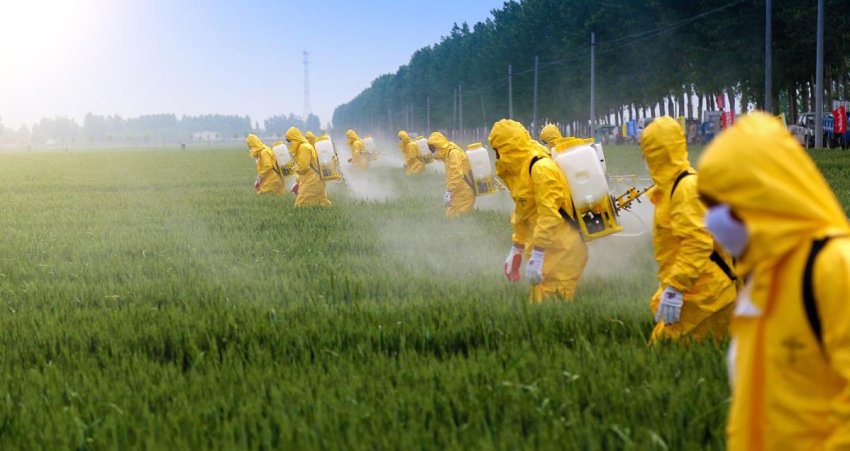
Poisoning Our Children: The Parent’s Guide to the Myths of Safe Pesticides
By Andre Leu
Acres USA, 2018
205pp
Andre Leu is an organic tropical fruit grower at Daintree in North Queensland. He is the former president of the International Federation of Organic Agriculture Movements (IFOAM), the peak world organic farming body.
His book, Poisoning Our Children: The Parent’s Guide to the Myths of Safe Pesticides, shows there is plenty of peer-reviewed science finding monumental faults with pesticide use and regulation — science ignored by regulators. Leu uses this science to show that pesticide safety is based on data-free myths.
There are five myths: that pesticides are rigorously tested; that residues in food are so small they are harmless; that pesticides quickly biodegrade; that regulations are reliable; and that pesticides are essential for agriculture.
A total of 232 chemicals have been found in placental cord blood of newborn babies in the United States. Many of these are endocrine disruptors, affecting the developing brain and hormones of children.
Even minute amounts are dangerous for foetuses and babies. Yet no safety tests are done on the young — all are performed on adolescent or adult animals (usually rats).
Some pesticides, such as glyphosate, the most widely used herbicide in the world, have a greater effect on hormones in parts per billion than in parts per million. This is because the body can only recognise higher amounts and reject them.
Pesticide exposure in children is linked to lower IQ, ADHD, autism, inability to manage anger, schizophrenia and depression.
Testing is only done on the active ingredient of a pesticide formulation, assuming that the additives are inert. Yet these are added to increase the pesticide’s killing power. Some are more toxic than the active ingredient.
Most pesticides have never undergone tests. Residues of glyphosate are not tested for in foods. Testing is not done on combinations of chemicals, yet most produce contains more than one type of chemical residue. Each interacts with the other, potentially dramatically increasing their impact.
When pesticides breakdown, the by-product is sometimes more toxic that the original. Malathion, one of the most common insecticides, breaks down into a compound 100 times more toxic. Regulators do not test for breakdown compounds.
Many countries have no pesticide regulatory system at all. In countries where a system exists, regulatory committees commonly contain representatives of the pesticide manufacturers.
Regulators rely on studies done by the manufacturer, which inevitably shows the product to be benign. These studies are commercial-in-confidence, unpublished and unavailable to independent scientists and the public. Independent studies, which are published in peer-reviewed scientific journals, are not considered by regulators.
This book contains graphs showing the stunning correlation of increased incidence of many common disorders with the huge growth in glyphosate use dating from 1995. This was when Roundup-resistant genetically modified corn, soy and canola became available.
These disorders include autism, thyroid cancer, obesity, Alzheimer’s disease, diabetes, bladder cancer, multiple sclerosis, intestinal infection and liver cancer. Correlation does not prove causation, but the chance of coincidence is estimated at one in 10,000.
It is only in recent years that the effect of glyphosate on gut microbes has been discovered. The above disorders are linked to poor digestion.
Leu tackles the myth that pesticides are essential to agriculture to prevent starvation. This is demonstratively false, as the studies of yields of a large number of organic farms in the world shows.
Organic farming is capable of achieving equal yields with no pesticide use, no net greenhouse gas production, greater biodiversity and lower energy use. Chemical farming also receives 99.6% of world agricultural research funding. With such funds, biological agriculture yields would be even higher.
I have been involved in the organic farming movement for more than 30 years and have written on pesticides many times. Yet I was shocked by the full extent of the danger.
Leu has done a great service, bringing together hundreds of peer-reviewed scientific investigations to show the scale of the deception. We cannot trust the regulatory system to ensure we do not eat contaminated food.
[Alan Broughton is a member of the Socialist Alliance and is active with the Organic Agriculture Association. He is a co-author of Sustainable Agriculture Versus Corporate Greed.]
Like the article? Subscribe to Green Left now! You can also like us on Facebook and follow us on Twitter.